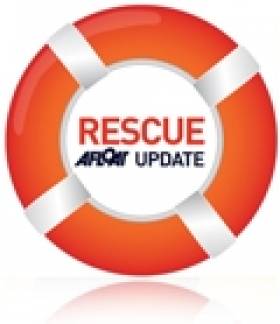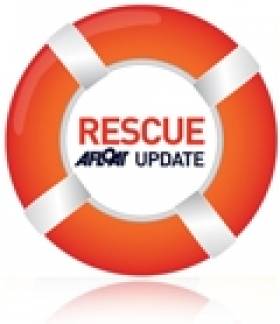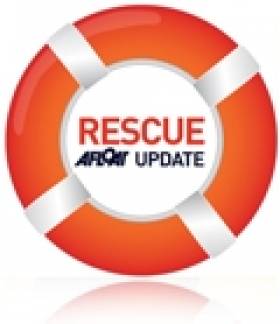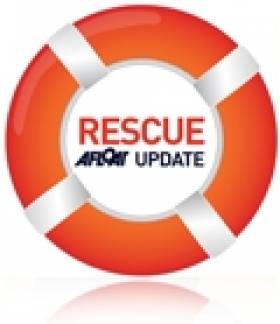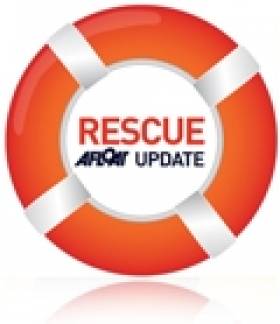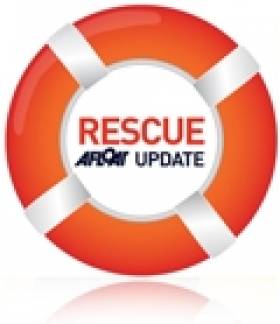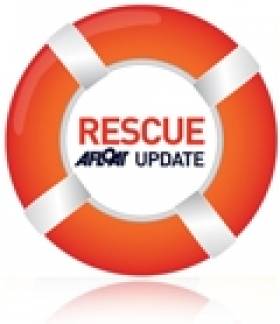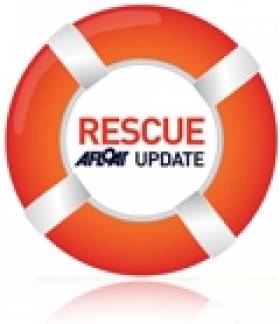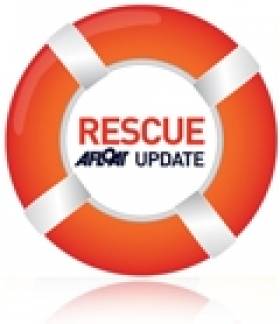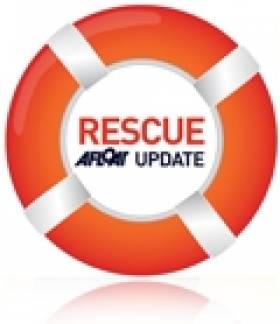Displaying items by tag: Rescue
Airlift For Russian Fisherman With Hand Injury
#Rescue - The Irish Times reports that a Russian fisherman is in hospital after sustaining serious hand injuries on a factory ship off Cork.
The man was airlifted from the Starry Arabat some 320km west of Slea Head yesterday morning (Tuesday 10 February) by the Shannon-based Irish Coast Guard helicopter Rescue 115.
By evening he had been transferred to Cork University Hospital for emergency surgery to save his hand.
The circumstances of the injury are not yet known, but The Irish Times has more on the story HERE.
Video Shows Shocking Moment As Aran Islands Trawler Disappears Under Scottish Waves
#Rescue - Mail Online has more on the dramatic rescue of Aran Islands fishermen from an Irish trawler that sank off Scotland's Outer Hebrides last week.
As previously reported on Afloat.ie, three of the five crew were airlifted to hospital with suspected hypothermia after the Iúda Naofa began taking on water some 48 miles off Lewis in the far north-west of Scotland.
But new video from HM Coastguard shows the shocking moment as the crew escaped their trawler just before it disappeared beneath the waves in a mere 35 seconds.
Minutes beforehand, coastguard crew members had attempted to clear the water from the boat with a salvage pump but the vessel was quickly overwhelmed.
Micheál Ó Conghaíle, a deckhand on the boat skippered by his father Mairtín, describes how what was a normal fishing expedition went south after the rough waters "got the better" of their pumps.
Yet he and the rest of the crew are thankful for getting out relatively unscathed just weeks after the loss of eight crew on a cargo ship in the Pentland Firth.
Mail Online has much more on the story HERE.
Stricken Solent Ship Under Tow to Southampton Port
#Rescue - Salvage teams have at last started to tow the stranded vehicle-carrier Hoegh Osaka, which is heading back to Southampton, reports BBC News.
The degree of list on the 51,770-tonne ship has been reduced substantially, allowing the vessel to be towed.
Earlier than planned, she is being towed up Southampton Water to Berth 101 at Southampton Docks.
Only yesterday afternoon, salvage teams announced a 'weather window' of 48 hours to ready the vessel and prepare the tow to the port from where she departed earlier this month and subsequently grounded in the Solent.
It transpired she was deliberately run aground on a sandbank due to difficulities leading to the ship to list. This led the crew to take action in preventing the ship to sink in the channel.
'Weather Window' to Move Stricken Solent Ship
#SolentSalvage – Hoegh Osaka, the vehicle transporter ship that stranded in the Solent, has according to salvage teams earlier today, a window of up to 48 hours to ready the vessel and be moved.
The 51,000 tonnes vessel which underwent pumping in recent days, at Alpha Anchorage between Lee-on-the-Solent and Cowes, had been listing at 52 degrees but is now at 25 degrees.
Salvors need it to be at five degrees before it can be towed back to port.
If the list is not reduced enough, the weather and tide conditions would not be right to start towing until Sunday. For more, click the BBC News report HERE.
Aran Islands Fishermen Rescued Off Scotland
#Rescue - Five crew on an Aran Islands fishing trawler were rescued yesterday (Tuesday 20 January) after the vessel sank off Scotland's Outer Hebrides.
As BreakingNews.ie reports, the trawler Iúda Naofa began tanking on water some 48 miles off Lewis in the far north-west of Scotland.
Three of the five crew were airlifted to hospital for treatment for hypothermia while the others were evacuated to a nearby fishing boat also from the Aran Islands.
According to The Irish Times, the Iúda Naofa is owned by Mairtín Ó Conghaíle of Inis Mór.
Four of its crew are natives of the islands, the fifth being a Romanian national.
Water Pumped from Stricken Solent Ship Hoegh Osaka
#SolentSalvage – So far about 800 tons of water has been pumped from the stricken vehicle-transporter Hoegh Osaka.
The Maritime and Coastguard Agency said the operation was "going well" but said progress was slower than Saturday's start because they have to reposition the pump so only clean water is discharged.
It said the vessel, which is being secured by tugs off Lee-on-the-Solent (and during the recent storm), is unlikely to be moved to Southampton Port before Wednesday.
For more, BBC has a report HERE.
Stricken Ship, Hoegh Osaka Weathers Solent Storm
#SolentSalvage - The stricken vehicle-transporter, Hoegh Osaka held its position in the Solent overnight, despite severe gales.
Tugs holding the vessel, which is anchored near Lee-on-the-Solent, as reported yesterday, had been ordered to let it go if they lost control in the storm.
Salvors are due to board the vessel by helicopter and boat to test the pumps and work on the ballast. About 3,000 tonnes of excess water remains on the vessel and some of the ship's cargo is submerged.
The 51,000-tonne ship, carrying 1,400 cars and 105 pieces of construction equipment, was beached deliberately on Bramble Bank sandbank on 3 January after it began listing as it left Southampton.
For more on this story, BBC News has a report here.
If 'Winds Take Over' Tugs to Abandon Solent Stricken Car-Transporter
#SolentSalvage- Tugs holding the listing stricken car-transporter, Hoegh Osaka (2000/51,000grt) in the Solent will according to BBC News, let go of the vessel if they lose control in gales set to sweep in.
The ship anchored at Alpha Anchorage, near Lee-on-the-Solent, has been positioned to re-ground on a sandbank.
Bram Sperling, from salvors Svitzer, said: "If the wind takes over the vessel we've informed the tugs to take care of themselves."
Severe gales of up to 75mph (120km/h) are expected on the south coast later.
As previously reported on Afloat.ie, on Saturday, one of the tugs helping to keep the ship in place collided with the vessel in high winds.
About 3,000 tonnes of excess water is also being kept in the vessel to give the ship stability in the expected stormy weather.
Hugh Shaw, of the Maritime Coastguard Agency (MCA), said: "The important thing is that the vessel is stable.
There is more coverage accompanied by photos in the BBC News report, by clicking HERE.
Tug Crashed Into Stricken Solent Car-Transporter Hoegh Osaka
#SolentSalvage - One of the tugs holding the stricken car-transporter Hoegh Osaka in the Solent has according to BBC News crashed into the vessel.
The tug moved from its position during high winds and collided with the ship with 1,400 cars on board during last Saturday afternoon.
No-one was injured but the tug was damaged and had to be replaced.
The salvage operation was hampered on Saturday because of poor weather conditions but the Maritime and Coastguard Agency (MCA) said salvors had since managed to board the ship.
The Svitzer salvage team is said to be refining its plans because further high winds are predicted.
The MCA said salvors were now intending to start work on the ship's ballast before pumping the 3,000 tonnes of water out of the vessel.
A spokeswoman said: "Yesterday, weather conditions prevented any activity on the vessel other than to connect the third tug.
As previously reported on Afloat.ie, an investigation has begun into the ship incident in which the owners, Hoegh Autoliners said she was deliberately ran aground off the Isle of Wight.
For more coverage the BBC News has a report here.
Solent Stricken Ship Is Pumped Out of 3,000 Tonnes of Water
#SolentGrounding- Poor weather is hampering operations to right the listing car-transporter Hoegh Osaka, reports BBC News.
Up to 3,000 tonnes of water is being pumped out of the hold of the cargo ship which ran aground in the Solent.
The Hoegh Osaka has been secured two miles (3.2km) east of the Bramble Bank sandbank from which as previously reported the vessel had freed itself on Wednesday.
Salvors said they were confident a "thin film of oil" on the water could be contained within the ship.
A spokesman for owners Hoegh Autoliners said work could be slowed down by forecast bad weather.
The 51,000-tonne vehicle transporter "refloated" itself unexpectedly at 14:00 GMT due to the high tide.
It was towed two miles east of Bramble Bank, where it was grounded on Saturday, and is being held by tugs between Cowes and Lee-on-Solent.
To read more of this story, click HERE.


























